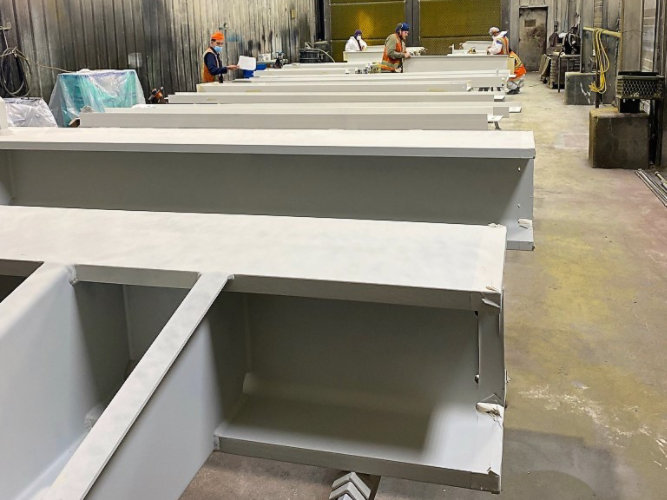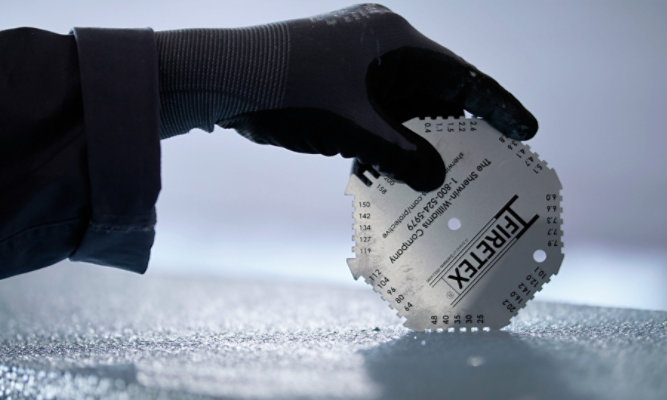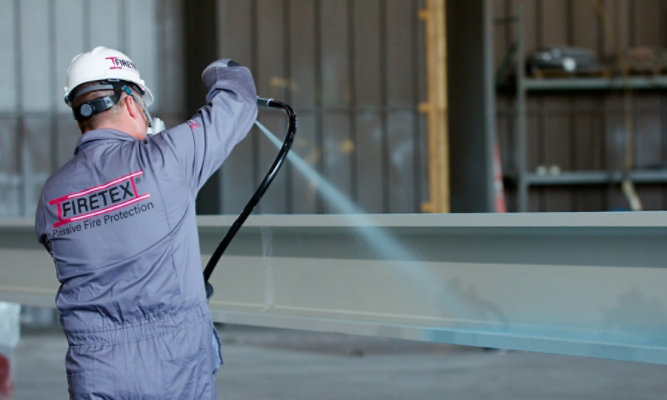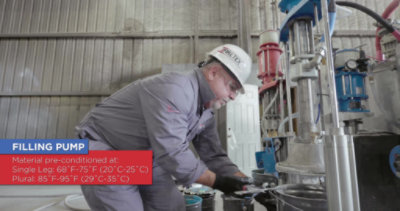Epoxy Intumescent Coatings for Fireproofing in Electric Vehicle Battery Plants
Comparing Cleanliness and Application Methods for Traditional and Intumescent Coatings
by Max Tritremmel, Global Fire Protection Portfolio Director, and Joe Windover, Construction Solutions Executive for Automotive and EV Battery, Sherwin-Williams Protective & Marine
Contact Us for More Information

The world of automotive manufacturing is changing at a rapid pace from traditional powertrain systems to electric battery-powered vehicles (EVs). This transition introduces new challenges for the design and building of manufacturing facilities. While traditional automotive manufacturing focused on machining and assembling of gas- and diesel-fired powertrain systems, new EV battery-powered vehicle plants have more in common with electronics manufacturing than they do with their carbon consuming cousins. As a result, they require cleaner environments and fire-resistant coatings that are appropriate for chemically intensive components.
In these new facilities, structural protection against fire is required by local building codes and dictated by the unique hazards of the EV battery manufacturing process. This structural protection takes the form of passive fire protection (PFP) with various types of insulative coatings, which are designed to prevent structural steel elements from collapse when exposed to high temperatures during a fire. In this paper, we will examine the unique requirements for PFP in modern EV Battery manufacturing facilities. In particular, we will review the limitations of low-density cementitious or fiber-based, spray-applied fire resistive materials (SFRMs), which are commonly used in traditional automotive construction because the applied costs are low. Then, we’ll consider cleaner, more efficient fireproofing coatings, including both acrylic and epoxy intumescent fire-resistive materials (IFRMs).
Electric Vehicle Manufacturing Creates the Need for Cleanroom Environments
As automotive manufacturing shifts to electric battery-powered vehicles (EVs), new, cleaner environments are required for manufacturing. Dust and other airborne contaminants can result in defects which can affect the performance and safety of the electronics systems and battery. As a result, building specifications and construction processes for automotive manufacturing are evolving, including those related to passive fire protection (PFP) of the steel structure.
In the electronics industry, product performance and reliability are greatly enhanced by controlling airborne contaminants in manufacturing and storage environments. For example, semiconductor manufacturing facilities have extreme requirements for outgassing, low dusting and environmental tolerances. As such, these sites require a special kind of PFP, not the low-density cementitious or fiber-based spray-applied fire resistive materials (SFRMs) that are commonly applied in traditional automotive facilities and other manufacturing environments. Instead, such structures are protected by intumescent fire-resistive materials (IFRMs), which are cleaner (Figure 1). Such IFRMs may be acrylic or epoxy coatings.
Lithium ion-based battery manufacturing requires environmental controls that are similar to other sectors of the electronics industry. For example, facilities may have cleanrooms, cleaning areas and special packaging areas as a means of containing contamination, as well as dry rooms that minimize moisture in the air because lithium reacts to it.
Figure 1. Intumescent fire-resistive materials (IFRMs) offer a clean, aesthetically pleasing alternative to spray-applied fire resistive materials (SFRMs), while meeting requirements for outgassing, low dusting and environmental tolerances in electronics manufacturing environments.
Requirements for dry rooms (where battery module and pack assembly would take place) would typically be ISO Class 7-6 cleanrooms, with below 1-10% relative humidity and a dew point of -40°F to -50°F (1). The battery cell manufacturing areas, where reactive components are mixed, may require even more stringent clean rooms, such as ISO Class 5 or 6, which further limit the concentration of airborne particles in both size and concentration in a cubic meter of airspace. As a result, PFP products for EV battery facilities need to be low dusting, low outgassing, non-friable and capable of operating in low relative humidity environments. The traditional SFRMs used in manufacturing facilities are unlikely to meet these performance standards and, therefore, are not an ideal solution for this emerging manufacturing category that combines electronics and automotive production.
Chemical Hazards
Beyond moisture content in the air, other chemical compatibility issues make SFRMs and acrylic IFRMs (as opposed to epoxy intumescent protective coatings) less appropriate for lithium ion-based battery manufacturing. In the manufacturing process of EV battery cells, two solvents are commonly used: N-methyl-2-pyrrolidone (NMP) and dimethyl sulfoxide (DMSO). These chemicals dissolve the active materials in the battery cell, such as lithium cobalt oxide (LiCoO2) and nickel manganese cobalt oxide (NMC). They may be mixed together and coated on the electrodes.
In recent years, there has been a growing movement to phase out the use of NMP and DMSO due to their environmental and health risks. Among the proposed alternatives are ethylene glycol dimethyl ether (EGDME) and propylene carbonate (PC). The use of EGDME and PC in the manufacturing process of EV battery cells is in its early stages. Still, the chemicals have the potential to be safer and more environmentally friendly alternatives to NMP and DMSO.
However, all four solvents would require a PFP coating system for the building’s steel structure that can handle the hazards of reactive, corrosive and/or flammable liquids and vapors. In the chemical processing space, epoxy IFRMs are a popular choice for intumescent fire protection due to their inherent chemical and environmental resistance. Those same characteristics make them ideal materials for the EV automotive environment as well and superior to their water- or solvent-borne acrylic counterparts or SFRMs.
Issues Related to Application and Construction
During the construction of manufacturing facilities, traditional PFPs, which are sprayed on after the steel members are installed, can present challenges in terms of timing, delays and coordination with other construction trades. Those challenges can almost completely disappear by moving the majority of PFP applications offsite and using epoxy intumescent coatings (Figure 2). Below, we review the process for applying different types of PFPs, including traditional SRFMs (applied on site), acrylic IFRMs (applied on site) and epoxy IFRMs (applied off-site, before construction).
On-Site Application with Fiber-Based or Cementitious SFRMs
The oldest and most traditional form of PFP, SFRMs consist of many materials, such as gypsum, vermiculite or Portland cement (commonly referred to as cementitious). They are usually spray coated onto the substrate with heavy duty spray pumps, or they may be applied with a trowel. These materials, particularly low-density SFRMs, are often favored for their relative economy on an installed cost basis.
In such instances, the coatings are applied after the steel frame has been installed and when environmental conditions are favorable. Oftentimes, the weather conditions need to be just right, or the space needs to be enclosed and/or conditioned to enable applications.
In addition, when applied on site, SFRMs must be coordinated with other processes. For example, mechanical and electrical contractors may need to install hanger systems for conduits, piping and ducting in advance of the SFRM application. Then, applicators will typically need to set up protected containments or enclosures before applying the SFRMs. Later, the subtrades will return to complete their scopes. If any hangers need to be relocated, it’s likely that the SFRM application would become damaged and may need to be repaired. In turn, the SFRM repair may affect the mechanical and electrical installations, which, in turn, may need to be repaired or cleaned, adding more time and labor not captured in original estimates. Much of this work occurs as time- and resource-consuming Time and Material Ticket work, which can be a hidden consumer of both project schedule and revenue.
On-Site Application with Single-Component, Acrylic IFRMs
Single-component, acrylic IFRMs present fewer challenges related to on-site coordination with other trades. Similar to SFRMs, they are also most often applied to the steel structure after it is installed. Depending on the application technology, these IFRMs can be applied before or after the building is enclosed but always before electrical and mechanical systems are installed.
However, single-component IFRMs often require multiple thinner coats to achieve the desired fire protection. These formulations have low solids, and the suspension vehicle, either water or solvent, needs to evaporate for the product to cure properly. So, the application in total may require several days waiting for this dry time between coats. If IFRMs are not applied at the proper film thickness or not allowed to cure between coats, blistering or premature failure may occur. Blistering (Figure 3) can also occur in uncontrolled application environments, for example, if the acrylic coatings are exposed to moisture (rain, dew, etc.) early in curing cycle. It’s also possible that in lieu of blistering, there may be a surface deposition or “melamine blush,” necessitating a wipe down between coats to ensure intercoat adhesion.
In sum, this category of coatings can be especially sensitive to the environment in which it is applied. Further, a troublesome application can dramatically delay schedules on the job site. If the coating remains soft, the drying schedule may need to be extended so the thickness of the film (in its cured state) can be verified.
After curing, subcontractors can install their electrical and mechanical systems. With IFRMs, it’s relatively simple to relocate hangers if the contacted surfaces meet the requirements of the UL Solutions’ Guide to Steelwork Fire Protection in regard to “Attachments” (2). The only caveat is that since acrylic films can remain soft, especially in thicker applications, which can result in compaction if hangers or other fixtures are applied on top of the coatings. If the film is soft, contractors should wait for the coating to finish curing before proceeding.
Offsite Application with Catalyzed Epoxy IFRMs
In addition to being cleaner and more resistant to chemical attack, catalyzed epoxy IFRMs carry the additional advantage of being applied off-site, in a shop setting, before the steel members are shipped to the job site and installed (Figure 4).
Epoxy IFRMs are applied at higher thicknesses per coat than their single component counterparts and achieve good hardness much faster (often overnight), which expedites the application process (Figure 5). For many other reasons, too, off-site applications are easier and faster: The applicators have easy, eye-level access to steel members from the ground, as do those responsible for quality control (Figure 6). No wands or manlifts are required. The characteristics of easy access, faster curing, fewer hold points and fewer manhours all add up to “more speed and less defects,” as well as lower labor costs.
Off-site applications provide the additional benefit of taking place indoors, which limits – or eliminates – the impact of cooler or hotter weather, as well as dew, rain or snow (Figure 7). As a result, curing schedules are more regular, as are quality checks and recoat times. Film formation defects, such as blistering or blushing, are rare, and even when rework or repair is required, it is faster, of a higher quality and costs less.
Epoxy IFRMs are uniquely suited to off-site applications because they produce a relatively damage-resistant coating that can stand up to loading, shipping and installation. Once installed, only the hold back areas for the connections need to be coated in the field, with limited man hours spent working at heights (Figure 8). Further, mechanical and electrical contractors can more easily install and relocate their hangers and attachments with greater productivity and less risk of damage, often improving both schedules and costs once the trades are aligned.
There is also a ripple effect to the advantages associated with the off-site application of epoxy IFRMs. Schedule predictability is greatly improved by taking the trade stacking bottleneck out of the field and dramatically reducing weather impacts. Removing these man hours from the field also greatly diminishes the number of man hours in the field working at height, which significantly reduces site safety risks. Financing costs for the building phase may also be less due to the improved time to service. In addition, the schedule improvement can greatly reduce general conditions impacts such as rentals, field offices, security hours, and management overhead and supervision costs. These cumulative costs are often overlooked when comparing the square-foot-installed cost for shop-applied epoxy IFRM installations vs. on-site application of SFRMs or single-component, acrylic IFRMs.
Function, Aesthetics and Sustainability
The benefits of shop-applied epoxy IFRMs also extend beyond the installation phase. The physical durability of epoxy coatings often leads to less maintenance requirements compared to other PFP materials (both SFRMs and acrylic IFRMs), in part, because of their superior corrosion protection. In addition, due to their robust nature and aesthetically pleasing finishes, epoxy IFRMs may not require column covers or other protection. While they generally don’t require topcoating, epoxy IFRMs, being smoother in finish than SFRMs, lend themselves to aesthetic topcoating. Once topcoated, the exposed steel can offer better light reflectance, which improves the brightness of a facility and may lower lighting costs and improve productivity.
Finally, 100% solids epoxy IFRMs are often better in terms of carbon impact on the environment, as compared to Portland cement-based SFRMs, which can be carbon intensive. Some IFRM manufacturers can provide Environmental Product Declarations (EPDs) that can verify carbon impacts for comparison.
Epoxy IFRMs – A Better Choice for Contractors and Building Owners
For EV automobile manufacturing facilities, which require environmental controls similar to other sectors of electronics manufacturing, epoxy and acrylic IFRMs are a cleaner choice than the SFRMs traditionally used in auto plants. In addition, epoxy IFRMs provide greater chemical resistance, as compared to acrylic IFRMs or SFRMs.
Epoxy IFRMs provide another set of advantages when it comes to construction. Because they can be applied off-site in a shop environment, they reduce manhours and the potential for weather-related problems related to curing or intercoat adhesion. For the primary contractor and trades, off-site application greatly reduces on-site challenges related to scheduling, delays, repairs and safety. All around, building conditions are improved and project outcomes are more predictable.
For the building owner, epoxy IFRMs may shorten the construction timeline, reducing financing costs. Further, they require less maintenance than the alternatives because of their superior chemical resistance. With their smooth finish, they may reduce the need for additional building components that hide steel. And, if topcoated, they can improve the ambiance visibility in a building.
REFERENCES
- “Building the World’s Biggest Lithium-Ion Battery Plant.” Cleanroom Technology, 28 July 2016, www.cleanroomtechnology.com/news/article_page/Building_the_worlds_biggest_lithium_ion_battery_plant/119947
- “UL Solutions’ Guide to Steelwork Fire Protection: Fire Resistance and External Exposure Characteristics.” UL Solutions. 2023.
ABOUT THE AUTHORS
Max Tritremmel is Global Fire Protection Portfolio Director for Sherwin-Williams Protective & Marine. Since 1997, he has served the coatings industry as a sales representative, business leader, industrial painting contractor and now marketer. He is an SSPC Protective Coatings Specialist and an SSPC Level 3 Certified Coatings Inspector. Contact: Max.Tritremmel@sherwin.com
Joseph Windover is a Construction Executive for Sherwin-Williams Construction Solutions. He joined Sherwin-Williams in 2016 and is currently responsible for helping general contractors build safer, faster, simpler facilities for the production of electric vehicle battery cells and semiconductors. He has helped build 13 EV battery factories since 2019, a feat no other construction service has achieved. Windover serves as a committee member with the Charles Pankow Foundation, where he is helping to develop modular steel floor innovations for tall building construction. He is a published contributor for the Institute for Construction Innovation and spoke at the Advancing Integrated Project Delivery Summit in 2022. Contact: Joseph.C.Windover@sherwin.com
Figure 2. Applying epoxy intumescent fireproofing off-site before constructing a building removes a host of challenges related to on-site timing, delays and coordination with other construction trades.
Figure 3. The risk of single-component IFRMs blistering increases in uncontrolled application environments in which moisture may interfere with the curing process, as well as when coatings are not applied at the proper film thickness or not allowed to cure between coats.
Figure 4. Due to their durability, epoxy IFRMs can be applied off-site, in a controlled shop setting, before the steel members are shipped to the job site and installed.
Figure 5. Epoxy IFRMs enable faster applications since they can be applied at high thicknesses per coat.
Figure 6. Off-site applications offer better quality control and enhanced safety, as applicators and inspectors have easy, eye-level access to steel members from the ground, with no wands or manlifts required.
Figure 7. Taking place indoors, off-site coatings applications limit – or eliminate – the impact of temperature variability and inclement weather, which can otherwise slow progress during on-site applications.
Figure 8. When epoxy IFRMs are applied in a shop, applicators purposely leave hold back areas at connection points. These and any areas where coatings may have been damaged during handling are the only areas applicators will need to coat in the field.
Discover More
Industry Expertise and Innovation
See how we help customers find customized solutions for their project and application challenges.
Our Fire Protection Expertise
Explore our industry solutions and technology to help protect your assets.
LEARN MOREProduct Lookup
Find out more about our innovative coatings for a variety of industries.
FIND A PRODUCT

